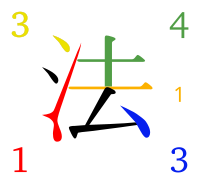

They are probably an improved method based on the "Four Corner Method", similar to the 'Three Corner Method" invented and registered by the "Wang Laboratories" (remember those "Wang" Keyboards?). These methods are no longer common for computer users nowadays.
Here's a more elaborated version:
I've been intrigued by this giant "ortholinear-keyboard-look-alike" input device, supposedly on display in a museum in München, discussed in an earlier post.


The device held an important position in the computing history in search of a solution for the Chinese characters (Kanji/Hanja/Hanzi). However it was doing things in a "brute force" way,, i.e. to visually find a character from 18x12x12 characters on a grid of relegendable keys clustered phonetically by Hiragana alphabets.
An input system is needed to include all the 80,000+ Kanji characters on the more common keyboards.
Nowadays, the most prevalent input systems in East Asia are all related to pronunciation, Korean using Hangul, Japanese using Hiragana and Katakana, Chinese using the Latin alphabets in Pinyin introduced in 1958 and the Taiwanese Mandarin Phonetic Symbols introduced in 1918 (on top of that there are a lot of non-Mandarin speaking Chinese, there are pronunciation based input methods for Min Chinese and Cantonese Chinese for the southern China region). However, pronunciation-based input methods for the Chinese language have been considered mediocre and have been avoided due to limitations of computing power of systems in the earlier years. There are reasons for the pronunciation-based input method being considered as mediocre and avoided.
The experience of pronunciation-based input method is like this: You type in the pronunciation and the matching characters will pop up for you to select. The problem of these methods is that every Kanji (at least in the Chinese language) has only one syllable, for a single pronunciation input, there can be lot of overlapping, i.e. a few pages of characters may match a single syllable input. In English, a user types "man" by hitting 3 keys, but in Chinese (and pronounced in Mandarin), one has to input the pronunciation (a few keys), waits for the pop-up menu to appear, and then selects the particular character from the list on the pop-up menu. In the past, pronunciation-based input method were not very usable for Chinese; this has become not as bad as the older days when the characters in these pop-up lists are now usually arranged by word frequencies and the orders will be updated according to the usage habit of users.
After the "brute force" method of Kanji input using the gigantic grid input device invented by IBM Yamato Lab in Japan, the first non-pronunciation-based input method was introduced by a computing company "Wang Laboratories" (https://en.wikipedia.org/wiki/Wang_Laboratories) founded by a Chinese computer scientist in the US. We can trace the origin of this non-pronunciation-based Chinese input method back earlier to the 1910s.
There was a Chinese character encoding method called the "Four Corner Method" invented in 1918 by Yun-wu Wang (https://en.wikipedia.org/wiki/Wang_Yun-wu) under "The Commercial Press" in Shanghai to facilitate the task of communication using Chinese telegraph code (CST). The method utilized only 10 keys: 0 to 9 to depicted the shape of a Chinese character.

https://zh.wikipedia.org/wiki/%E5%9B%9B ... F.E5.89.87
The Chinese input method implemented in the early IBM Chinese computer was likely based on this "Four Corner Method" and likely be the one introduced by the "Wang Laboratories" in 1971, called the "Three Corner Method". This input method for computer is probably the earliest Chinese input method in computing history.
https://zh.wikipedia.org/wiki/%E4%B8%89 ... F%E6%B3%95
If what I read is correct, the earliest input method for Traditional Chinese was Cangjie (named after the mythical historical figure who designed Chinese characters) introduced in 1976, and for Simplified Chinese was Wubi (meaning "five-stroke") introduced in 1983. AFAIK, these two systems now works for both Traditional Chinese and Simplified Chinese.
Spoiler: